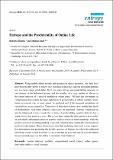| dc.contributor.author | Sinatra, Roberta | |
| dc.contributor.author | Szell, Michael | |
| dc.date.accessioned | 2014-05-30T15:16:22Z | |
| dc.date.available | 2014-05-30T15:16:22Z | |
| dc.date.issued | 2014-01 | |
| dc.date.submitted | 2013-12 | |
| dc.identifier.issn | 1099-4300 | |
| dc.identifier.uri | http://hdl.handle.net/1721.1/87582 | |
| dc.description.abstract | Using mobile phone records and information theory measures, our daily lives have been recently shown to follow strict statistical regularities, and our movement patterns are, to a large extent, predictable. Here, we apply entropy and predictability measures to two datasets of the behavioral actions and the mobility of a large number of players in the virtual universe of a massive multiplayer online game. We find that movements in virtual human lives follow the same high levels of predictability as offline mobility, where future movements can, to some extent, be predicted well if the temporal correlations of visited places are accounted for. Time series of behavioral actions show similar high levels of predictability, even when temporal correlations are neglected. Entropy conditional on specific behavioral actions reveals that in terms of predictability, negative behavior has a wider variety than positive actions. The actions that contain the information to best predict an individual’s subsequent action are negative, such as attacks or enemy markings, while the positive actions of friendship marking, trade and communication contain the least amount of predictive information. These observations show that predicting behavioral actions requires less information than predicting the mobility patterns of humans for which the additional knowledge of past visited locations is crucial and that the type and sign of a social relation has an essential impact on the ability to determine future behavior. | en_US |
| dc.description.sponsorship | National Science Foundation (U.S.) | en_US |
| dc.description.sponsorship | Singapore-MIT Alliance for Research and Technology Center | en_US |
| dc.description.sponsorship | Coca-Cola Company | en_US |
| dc.description.sponsorship | Ericsson, Inc. | en_US |
| dc.description.sponsorship | Massachusetts Institute of Technology. SENSEable City Laboratory Consortium | en_US |
| dc.language.iso | en_US | |
| dc.publisher | MDPI AG | en_US |
| dc.relation.isversionof | http://dx.doi.org/10.3390/e16010543 | en_US |
| dc.rights | Creative Commons Attribution | en_US |
| dc.rights.uri | http://creativecommons.org/licenses/by/3.0/ | en_US |
| dc.source | MDPI Publishing | en_US |
| dc.title | Entropy and the Predictability of Online Life | en_US |
| dc.type | Article | en_US |
| dc.identifier.citation | Sinatra, Roberta, and Michael Szell. “Entropy and the Predictability of Online Life.” Entropy 16, no. 1 (January 16, 2014): 543–556. | en_US |
| dc.contributor.department | Massachusetts Institute of Technology. Department of Urban Studies and Planning | en_US |
| dc.contributor.department | Massachusetts Institute of Technology. SENSEable City Laboratory | en_US |
| dc.contributor.mitauthor | Szell, Michael | en_US |
| dc.relation.journal | Entropy | en_US |
| dc.eprint.version | Final published version | en_US |
| dc.type.uri | http://purl.org/eprint/type/JournalArticle | en_US |
| eprint.status | http://purl.org/eprint/status/PeerReviewed | en_US |
| dspace.orderedauthors | Sinatra, Roberta; Szell, Michael | en_US |
| mit.license | PUBLISHER_CC | en_US |
| mit.metadata.status | Complete | |
